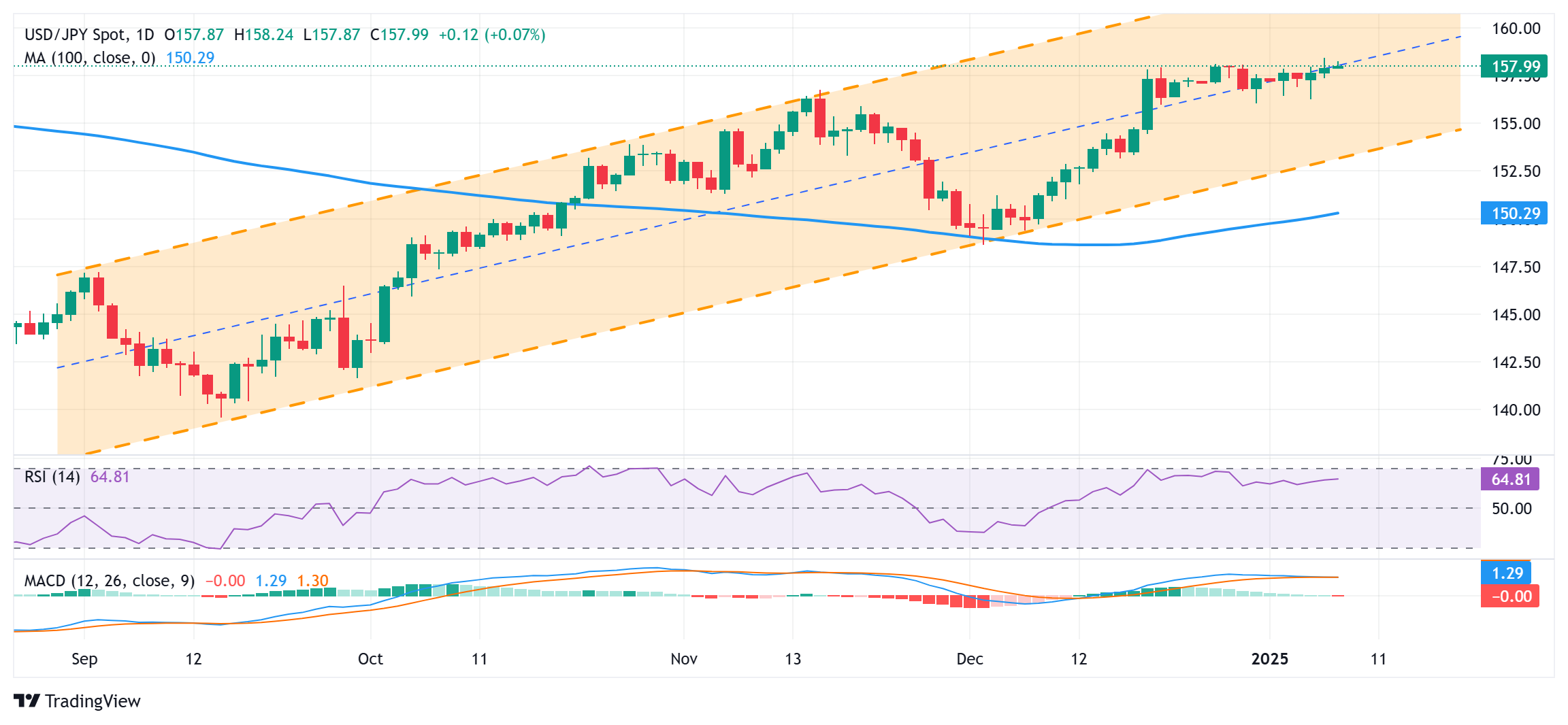Japanese Yen hangs near multi-month low against USD; seems vulnerable
- The Japanese Yen continues to be undermined by the BoJ rate-hike uncertainty.
- The widening US-Japan yield differential further weighs on the lower-yielding JPY.
- The Fed’s hawkish stance acts as a tailwind for the USD and the USD/JPY pair.
The Japanese Yen (JPY) languishes near a six-month low against its American counterpart and seems vulnerable to prolonging a one-month-old downtrend amid uncertainty about the timing of the next rate hike by the Bank of Japan (BoJ). Adding to this, the recent widening of the US-Japan yield differential, bolstered by reduced bets for further rate cuts by the Federal Reserve (Fed), validates the near-term negative outlook for the lower-yielding JPY. That said, a combination of factors might hold back the JPY bears from placing fresh bets.
Japan’s Finance Minister Katsunobu Kato weighed in with some verbal intervention on Tuesday. This, along with concerns about US President-elect Donald Trump's tariff plans, geopolitical risks and the cautious market mood, could offer some support to the safe-haven JPY. Investors might also prefer to wait for the release of the FOMC meeting Minutes. In the meantime, the Fed's hawkish outlook remains supportive of the underlying US Dollar (USD) bullish tone, which assists the USD/JPY pair to hold steady above the 158.00 mark.
Japanese Yen bears retain control amid doubts over the timing of the next BoJ rate hike
- The Bank of Japan has kept markets guessing on how soon it could hike interest rates again, which continued to undermine the Japanese Yen and lifted the USD/JPY pair to a near six-month high on Tuesday.
- BoJ Governor Kazuo Ueda said on Monday that the central bank will raise interest rates further if the economy continues to improve, though the timing depends on economic, price and financial developments.
- Some investors are betting on the possibility of a BoJ rate hike at the January 23-24 meeting amid the broadening inflationary pressures in Japan, while others see a stronger chance of a move in March or beyond.
- The yield on the benchmark 10-year Japanese government bond (JGB) rose to its highest level since July 2011, though it failed to provide any respite to the JPY bulls amid the widening US-Japan yield differential.
- The US Treasury yields extended the recent uptrend after data released on Tuesday pointed to a resilient economy, suggesting that the Federal Reserve could cut interest rates fewer times this year than expected.
- The Institute for Supply Management reported that its Non-Manufacturing Purchasing Managers' Index (PMI) rose to 54.1 in December and the Prices Paid component rose to the highest since September 2023.
- Separately, the Job Openings and Labor Turnover Survey (JOLTS) showed that the number of job openings on the last business day of November stood at 8.09 million, up from the 7.83 million reported in October.
- The data was consistent with a strong pace of economic activity, which, along with US President-elect Donald Trump's policies, could reignite inflationary pressures and cast doubt on further rate cuts by the Fed.
- Traders now look forward to the US economic docket – featuring the release of the ADP report on private-sector employment and the usual Weekly Initial Jobless Claims data – for short-term opportunities.
- The focus, however, will remain glued to the FOMC meeting Minutes, due later during the US session, which should influence the US Dollar (USD) ahead of the closely-watched US Nonfarm Payrolls report on Friday.
USD/JPY seems poised to appreciate further; the 157.00 mark holds the key for bulls
From a technical perspective, acceptance above the 158.00 round figure, along with positive oscillators on the daily chart, favor bulls for additional gains. Hence, a subsequent strength towards the 159.00 mark, en route to the 159.45 intermediate hurdle and the 160.00 psychological mark, looks like a distinct possibility.
On the flip side, the 157.60 area now seems to protect the immediate downside ahead of the 157.35-157.30 zone and the 157.00 mark. The latter should act as a pivotal point, below which the USD/JPY pair could slide to the 156.25 intermediate support en route to the 156.00 mark. Some follow-through selling might negate the positive bias and pave the way for a deeper corrective decline.
Japanese Yen FAQs
The Japanese Yen (JPY) is one of the world’s most traded currencies. Its value is broadly determined by the performance of the Japanese economy, but more specifically by the Bank of Japan’s policy, the differential between Japanese and US bond yields, or risk sentiment among traders, among other factors.
One of the Bank of Japan’s mandates is currency control, so its moves are key for the Yen. The BoJ has directly intervened in currency markets sometimes, generally to lower the value of the Yen, although it refrains from doing it often due to political concerns of its main trading partners. The BoJ ultra-loose monetary policy between 2013 and 2024 caused the Yen to depreciate against its main currency peers due to an increasing policy divergence between the Bank of Japan and other main central banks. More recently, the gradually unwinding of this ultra-loose policy has given some support to the Yen.
Over the last decade, the BoJ’s stance of sticking to ultra-loose monetary policy has led to a widening policy divergence with other central banks, particularly with the US Federal Reserve. This supported a widening of the differential between the 10-year US and Japanese bonds, which favored the US Dollar against the Japanese Yen. The BoJ decision in 2024 to gradually abandon the ultra-loose policy, coupled with interest-rate cuts in other major central banks, is narrowing this differential.
The Japanese Yen is often seen as a safe-haven investment. This means that in times of market stress, investors are more likely to put their money in the Japanese currency due to its supposed reliability and stability. Turbulent times are likely to strengthen the Yen’s value against other currencies seen as more risky to invest in.

